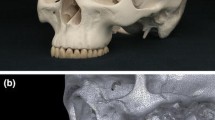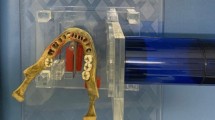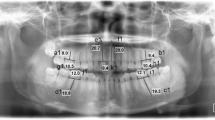Abstract
Objective
To evaluate whether the automatic exposure compensation in the presence of high-density materials can affect the measurement of alveolar bone level.
Methods
Thirty regions of seven dry skulls and six mandibles were radiographed with and without a high-density material, using two digital radiographic technologies: photostimulable phosphor plate (PSP, Digora Optime) and sensor (CMOS, Digora Toto), totaling 120 images. The distances from the cement–enamel junction to the alveolar bone crest were measured using cone-beam computed tomography (CBCT) images to represent the reference standard. The same measurements of alveolar bone level and the average of the pixel values of the image were evaluated on the radiographs. Paired t test compared the average pixel values and alveolar bone-level measurements between images with and without high-density material. One-way analysis of variance compared the difference between radiographic and CBCT measurements (α = 0.05).
Results
The high-density material reduced the pixel values in PSP (p = 0.002) and CMOS (p < 0.001) technologies, demonstrating the AEC functioning in both technologies. There was no difference in bone-level measurements between the images without and with the high-density material for both technologies (p ≥ 0.091), or between the tomographic and radiographic measurements (p ≥ 0.319).
Conclusion
In the presence of high-density material, the automatic exposure compensation reduces the average pixel values of the images (i.e., images get darker), but does not influence the radiographic measurements of alveolar bone level.



Similar content being viewed by others
References
Papapanou PN, Sanz M, Buduneli N, Dietrich T, Feres M, Fine DH, et al. Periodontitis: consensus report of workgroup 2 of the 2017 world workshop on the classification of periodontal and peri-implant diseases and conditions. J Periodontol. 2018;89:S173–82. https://doi.org/10.1002/JPER.17-0721.
Teeuw WJ, Coelho L, Silva A, van der Palen CJNM, Lessmann FGJM, van der Velden U, et al. Validation of a dental image analyzer tool to measure alveolar bone loss in periodontitis patients. J Periodontal Res. 2009;44:94–102.
Nieri M, Muzzi L, Cattabriga M, Rotundo R, Cairo F, Prato GPP. The prognostic value of several periodontal factors measured as radiographic bone level variation: a 10-year retrospective multilevel analysis of treated and maintained periodontal patients. J Periodontol. 2002;73:1485–93.
Aziman C, Hellén-Halme K, Shi X-Q. A comparative study on image quality of two digital intraoral sensors. Dentomaxillofac Radiol. 2019;48:1–5.
El-Ela WHA, Farid MM, El-Din Mostafa MS. Intraoral versus extraoral bitewing radiography in detection of enamel proximal caries: an ex vivo study. Dentomaxillofac Radiol. 2016;45:20150326.
Yasa E, Yasa B, Aglarci OS, Ertas E. Evaluation of the radiopacities of bulk-fill restoratives using two digital radiography systems. Oper Dent. 2015;40:1–9.
Galvão NS, Leandro Nascimento EH, Gaêta-Araujo H, Freitas DQ, Haiter-Neto F, Oliveira ML. Automatic exposure compensation and subjective image enhancement in the radiographic diagnosis of caries. Braz Oral Res. 2020;34:1–8.
Yoshiura K, Nakayama E, Shimizu M, Goto TK, Chikui T, Kawazu T, et al. Effects of the automatic exposure compensation on the proximal caries diagnosis. Dentomaxillofac Radiol. 2005;34:140–4.
Hayakawa Y, Farman AG, Scarfe WC, Kuroyanagi K. Pixel value modification using RVG-4 automatic exposure compensation for instant high-contrast images. Oral Radiol. 1996;12:11–8. https://doi.org/10.1007/BF02351577.
Galvão NS, Nascimento EHL, Lima CAS, Freitas DQ, Haiter-Neto F, Oliveira ML. Can a high-density dental material affect the automatic exposure compensation of digital radiographic images? Dentomaxillofac Radiol. 2019;48:2–7.
Schropp L, Alyass NS, Wenzel A, Stavropoulos A. Validity of wax and acrylic as soft-tissue simulation materials used in in vitro radiographic studies. Dentomaxillofac Radiol. 2012;41:686–90.
Dashpuntsag O, Yoshida M, Kasai R, Maeda N, Hosoki H, Honda E. Numerical evaluation of image contrast for thicker and thinner objects among current intraoral digital imaging systems. BioMed Research International [Internet]. Hindawi; 2017;2017:1–10. https://www.hindawi.com/journals/bmri/2017/5215413/
Choi IGG, Cortes ARG, Arita ES, Georgetti MAP. Comparison of conventional imaging techniques and CBCT for periodontal evaluation: a systematic review. Imaging Sci Dent. 2018;48:79. https://doi.org/10.5624/isd.2018.48.2.79.
Funding
This study was financed in part by the Coordenação de Aperfeiçoamento de Pessoal de Nível Superior—Brasil (CAPES)—Finance Code 001.
Author information
Authors and Affiliations
Corresponding author
Ethics declarations
Conflict of interest
The authors declare no conflict of interest.
Ethical approval
This study was approved by the local research ethics committee (CAAE. 11542919.0.0000.5418). The study was performed in accordance with the ethical standards as laid down in the 1964 Declaration of Helsinki and its later amendments or comparable ethical standards.
Informed consent
Not applicable.
Additional information
Publisher's Note
Springer Nature remains neutral with regard to jurisdictional claims in published maps and institutional affiliations.
Rights and permissions
About this article
Cite this article
Gaêta-Araujo, H., Oliveira-Santos, N., de Oliveira Reis, L. et al. Automatic exposure compensation of digital radiographic technologies does not affect alveolar bone-level measurement. Oral Radiol 39, 53–58 (2023). https://doi.org/10.1007/s11282-022-00599-x
Received:
Accepted:
Published:
Issue Date:
DOI: https://doi.org/10.1007/s11282-022-00599-x




